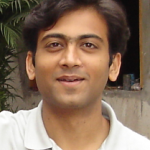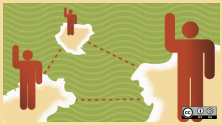FUDCon is the Fedora Users and Developers Conference, held multiple times a year in different parts of the world. Each region (North America, EMEA, LATAM, APAC, and Africa) gets one conference per year, and Fedora enthusiasts are invited to submit bids to host the conference in their regions.
Goals of a FUDCon
- Getting the community together, to interact face-to-face
- Host a combination of talks, workshops, and hackfests, where contributors work on specific initiatives. Topics include infrastructure, feature development, community building, general management and governance, marketing, testing and QA, packaging, etc.
- Spread the knowledge
- Invite more contributors
- Make new friends
Preparation
The preparations for this FUDCon in India really started years ago. The first mini-FUDCon in India happened in 2006 in New Delhi during the Linux Asia conference. Fedora contributors Greg DeKoenigsberg and Chris Blizzard inspired a few people at that conference. These early community members then worked on spreading the inspiration and building a community through the years.
At a conservative estimate, more than 1,000 packages in the Fedora repository are now maintained by the community they grew in India. India also has the second highest number of Fedora Ambassadors in the world (at 31 people). India also has a Red Hat office in Pune, where a lot of Fedora contributors, who aren't all ambassadors, work.
The FUDCon bidding process usually starts a year in advance. However, since APAC hadn’t recently held a FUDCon, the process started late for us. The bid was opened in June of 2011, and we got to work as soon as the bid process was announced, submitting our proposal on the same day. The first thing we checked was whether we could conduct the event within the allotted budget. This meant detailing each activity we would perform and approximating spending we'd incur in each activity. Activities here included transportation and travel for speakers, meals, FUDPub, venue, electricity, wireless, bandwidth, shwag, printing of banners and posters, etc. COEP, a local engineering college, agreed to host the event.
The travel costs were where we then expected our majority of funds to flow. The FUDCon planning committee meets once a week to discuss the event, including reviewing travel subsidy requests. We focused on requests from Indians, followed by those from APAC community members, and last from the international members. We ended up approving almost all requests we got, just barring some from people whom we hadn't seen too many Fedora contributions from in the past.
At the end of it all, we managed to stay well within the budget, even saving some money. We tracked all of the expenditures openly in a spreadsheet on the FUDCon Pune Wiki page.
Transparency in everything we did came naturally. Since the majority of the organizers were in Pune and working for Red Hat, we used to have weekly face-to-face meetings and post the meeting minutes up on a blog post that was syndicated to the Fedora Planet feeds.
Posting these updates in a central place also helped people step up when some members weren't available due to holidays or vacations. For all external communication (for example, with the caterers), at least two people from the organizing committee got involved, so that things didn't get stuck on one person.
Towards the later stages of the event, we involved a few student volunteers from COEP to manage the on-site details. One of the organizers was the lead for each of the activities, ensuring that if anything went wrong, we could pass on the message quickly and effectively. Thankfully, we never faced any major problems once the event started--it went quite smooth and the talks ran on time, even though we had a minimum of four talks going on at the same time, in different rooms.
A big help to us was the support extended by the Red Hat Pune facilities team. They arranged cabs for us and helped us with logistics, infrastructure (power point extensions for rooms, wireless routers), and catering.
Venue
COEP has a rich history. It's the third oldest engineering college in Asia, established in 1854 and considered by many to be the most prestigious engineering college under Pune University. Recently the college became fully autonomous, allowing the staff to set their own curricula. This has helped in some free and open source software penetration within the campus, since the choice of software being used is now actually made by the staff and students.
The college has a few free software enthusiasts among the students as well as the faculty, and they have a lab that hosts computers with only free software on them. The members of CoFSUG (COEP Free Software Users Group) helped spread the message of FUDCon, and we did see quite a good participation, in spite of ongoing exams, from the college.
The venue was not prepared to host a conference like FUDCon in a few respects--the rooms did not have enough power outlets for charging laptops. We had to make some arrangements to ensure the wireless signal strength was adequate for all the rooms and that the routers could sustain a large number of simultaneous users. On the positive side, though, COEP has good Internet connectivity, a 900-person capacity auditorium, and a few classrooms/seminar halls that could seat 100+ people.
Things we did differently from other FUDCons
- No barcamp format: We had a lot of talks submitted (50+) via the web interface, and a lot of attendees who registered (600+) as well. This meant if we were to host a barcamp for selecting the talks, there would be a lot of confusion for the voting and filtering of talks. What we did instead was to have voting on the website itself and schedule all the talks in a few parallel sessions. This did split the crowd, but we think it helped overall to manage confusion and speed up the event.
- Sponsor lunch and travel for speakers and international delegates: Since Pune doesn't have a truly international airport, we chose to fly in people to Mumbai and arrange cabs for the Mumbai-Pune travel. Mumbai is about 150 kms from Pune, about 4 hours’ drive. While traveling to Mumbai instead of Pune does save on cost, it adds to the travel time for people coming in after a long journey. We hope people didn't mind this extra road travel.
Lunch was also served for the three days of the conference for all the speakers, international delegates, organizers and volunteers. On the final day, the day of the hackfests, we provided lunch to everyone who attended. - Speakers’ room: While this hasn't been done at other FUDCons, we have seen a separate area for speakers at other conferences. Although it lets speakers shut themselves off from attendees and miss chances to interact with others, it also gives them a place to relax, refine their slides before their talks, and get refreshments.
- Website: We had a website (http://fudcon.in) to handle attendee registrations, talk submissions, and votes. This hasn't been done for any of the FUDCons yet, and we hope to use our experiences and knowledge to help organize future FUDCons.
- Organized two FADs leading up to the FUDCon: Since we expected a lot of students to attend the sessions at FUDCon, we organized two Fedora Activity Days (FADs), one at the Red Hat Pune office, and one at COEP. These FADs offered basic information about Fedora in general so that students could get the most out of FUDCon. The FADs were well-attended. People got to install Fedora on their laptops and college lab machines, set up a Fedora mirror locally in the college, and got initiated to the world of FOSS and Fedora.
- Live streaming and recording: We had live streaming of some talks happening on the second day. All the talks that happened in the auditorium were recorded and are available to view on the videographers' website. We also have access to the raw video dumps (33 GB in all!), which will be transcoded to open formats and uploaded. Look for announcements on Planet Fedora.
Photos
Videos of talks in the auditorium:
- http://urtalk.kpoint.in/playlist/view/29
- https://www.youtube.com/watch?v=DLEZzXUVT50
- http://www.youtube.com/watch?v=kIlUwysK9iQ
Impressions
- Largest FUDCon yet in terms of talks and attendees: We had more than 500 people and 50 talks over three days, making FUDCon Pune 2011 the largest FUDCon ever. Hosting such a big FUDCon puts us in a good position to reach out to many potential contributors. Many of the attendees were new to Fedora (some new to even free software). Quite a few turned up on the final hackfest day to continue discussions and also get a feel of packaging software or diving deep into internals of writing coding or designing artwork.
- Sessions not restricted to Fedora: We aimed at building communities of contributors and welcomed all talks related to various projects. Since Fedora itself thrives on upstream software, this came naturally for the FUDCon as well.
- We had discussions with attendees from other APAC regions, like Philippines, Malaysia, Bangladesh and Sri Lanka. We discussed what went into organizing an event like this, and what they could do to host such events in their countries. As a result, the teams from the Philippines and Malaysia have already submitted their bids for next year.
- In spite of the many talks and the spread-out rooms, we had the talks start and end on time. A German speaker, Joerg “Kital” Simon, said the talks were running “with German precision.”
- Hackfest: The last day was devoted to hackfests. After the previous night's FUDPub party, the speakers were a little late to arrive. The hackfest owners pitched barcamp-style and met in small groups in the auditorium and the two seminar halls, getting things done.
- Packaging: There were quite a few packaging requests, and several people worked on packaging new software. The hackfest day saw quite a few people learning and packaging software for Fedora.
- Keysigning: GPG keysigning took place all throughout the event, building the web of trust for the Fedora project.







Comments are closed.